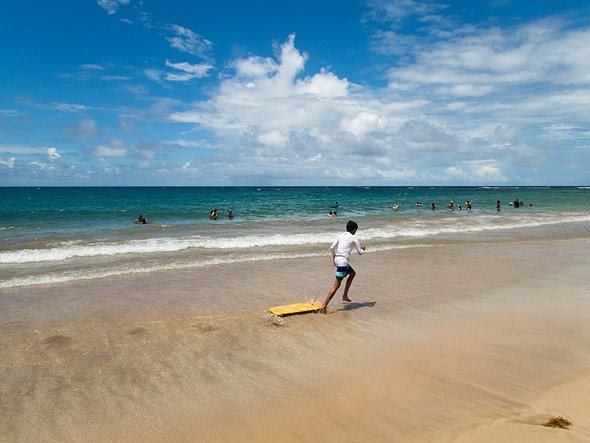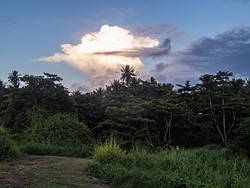José Francisco Salgado is an astronomer, science photographer, and visual artist. His series of Science & Symphony films that have been presented in more than 200 concerts in 15 countries. He is a native of Puerto Rico.
Editor's note: The events described in this article took place several weeks prior to the arrival of Hurricane Maria, which caused catastrophic damage to Puerto Rico and other islands in the Caribbean.
Last summer I traveled to Puerto Rico to do some night photography for a new Science & Symphony film I'm producing. I was planning to photograph the Milky Way and the ocean at the same time, though it's difficult to visit tropical beaches and limit yourself to work.
I shoot my time-lapse sequences with Nikon DSLRs, but decided to bring along two 'rugged' cameras, the Nikon Coolpix W300 and Olympus TG-5, for casual shooting. These point-and-shoot cameras are shockproof (rated to resist drops from at least 2.1m / 7ft) and waterproof (to depths of at least 15.2m / 50ft), so my motivation was to use them while snorkeling with my fiancée, Paula.
She was more than happy to try these cameras, and since she's not a professional photographer I thought it would be good to get her impressions of them as well. I wanted to find out how intuitive the controls were myself, so I decided to consult the manuals only when needed.
Olympus TG-5 sample gallery
One big difference between the cameras that's worth calling out is Raw support: the TG-5 allows you to capture Raw images, but the W300 shoots only in JPEG. I found myself processing the images from both cameras quite a bit in Adobe Lightroom to get pleasing results, though with the Nikon I was limited to editing out-of-camera JPEGs.
I really like the fact that both cameras have built-in GPS for geotagging photos. (You can read the metadata in the sample galleries if you want to know exactly where these photos were taken.) Unfortunately, after returning from the trip I noticed that the cameras, especially the TG-5, didn't geotag consistently.
Nikon W300 sample gallery
Since the W300 doesn't save Raw files, I've included both out-of-camera JPEGs and my edited JPEGs in this sample gallery.
After landing in San Juan, we headed eastward toward our base in Playa Azul in Luquillo. Playa Azul, aka the Costa Azul, is a beach with golden sand and turquoise water. We took some photos along the surf and started to familiarize ourselves with the cameras. Paula noticed how much easier it was to operate the zoom lever on the TG-5, which is sideways and closer to the shutter, than on the W300, which moves up and down. Nevertheless, the optical zoom itself worked well in both cameras. Paula also preferred the grip on the TG-5.
We then headed to Cabo Rojo in the southwest corner of the island to photograph the disk of our Galaxy setting in the Caribbean Sea in the context of the rugged coastline and promontory of Los Morrillos. We returned to the site during the day with our point-and-shoot cameras to photograph the coastline and the popular stone bridge.
After Cabo Rojo, we spent a night at the Punta Tuna Wetlands Nature Reserve in Maunabo in order to photograph The Milky Way and the Punta Tuna Lighthouse. We did some scouting around the wetland and Playa Larga, where we appreciated the advantage of shooting in Raw on the TG-5. In the split-screen image below, you can see how much more information I was able to extract by processing the Raw file in Lightroom.
Puerto Rico's Playa Azul has golden sand and turquoise water.
Olympus TG-5
ISO 100 | 1/400 sec. | F8
Photo by Paula Bressman
Our next site was Culebra, an island-municipality east of Puerto Rico, which is quickly reached by plane. During the 15-minute flight, Paula captured a nice photo of a young boy transfixed by the view from the small plane using the W300. I was able to pull a bit more shadow detail from the JPEG file, but decided not to so the viewer could focus on the boy's attentive face.
Then it was finally time to take the cameras underwater, so we took them to a couple of beaches in Culebra, Playa Melones and Playa Tamarindo. (We preferred Playa Melones due to its abundance of coral reefs and marine life.)
To use the cameras underwater all you need to do is secure a lock (or two, in the case of the TG-5) and enjoy! Considering that these cameras don't float, I recommend using the included straps to avoid accidental loss in deep water. Regardless of how much underwater photography you're interested in doing, it's good to know that you can bring these cameras into the water instead of leaving them unattended on the beach.
The color rendition on the TG-5's underwater photos was much better, so I decided to shoot more with it while snorkeling. Underwater, colors change based on lighting conditions, depth, water transparency, and amount of sunlight, so I was also intrigued to see how the TG-5's flash would perform underwater. I found that many of the images came out overexposed or washed out, so I stuck to using the best natural light possible (read waiting for passing clouds).
My fiancée, Paula, captured this photo during our flight to Culebra.
Nikon W300
ISO 400 | 1/1000 sec. | F2.8
Photo by Paula Bressman
The TG-5 has an Underwater Mode that, according to the manual, is optimized for underwater photography using natural light, so I decided to use it. According to the manual it should automatically set the ISO sensitivity with a priority on image quality. That is, the camera starts with a low ISO value and sets the corresponding exposure parameters (speed and aperture), then increases the ISO value as needed.
As sunlight started to diminish, it surprised me that the TG-5 would lower the speed all the way down to 1/60 second while maintaining ISO 100 instead of increasing the ISO! I understand that auto-ISO increases the ISO as a last recourse, but I was shooting in Underwater Mode. This mode should consider that sea currents are moving the photographer, who is often trying to capture moving fish or other animals. A speed of 1/60 second won't cut it.
Snorkeling near Playa Tamarindo.
Olympus TG-5
ISO 100 | 1/320 sec. | F2.8
Photo by Jose Francisco Salgado
I decided to manually change the ISO to a higher value, but alas, it was impossible to figure out how to change this setting without reading the manual, and therein lies my frustration. I can deal with a program mode not giving the results that I expect, however I do expect to be able to look at the buttons and quickly figure out how to change the parameters that I need to change. The problem wasn't pressing small buttons underwater, but not having an intuitive way to change values. As a result, some of the sea creatures I photographed are motion-blurred. Nevertheless, I'm content the photos I got of the carey de concha (Hawksbill sea turtle).
Throughout a day of snorkeling I got the impression that battery life on the W300 was underwhelming compared to the TG-5.
Shooting underwater with the Olympus TG-5.
On our last day in Culebra, stormy weather moved into the Caribbean. Conditions were windy, but safe, so we hopped into our rented golf cart and ventured out to enjoy two beaches which have been rated among the most beautiful in the world, Playa Flamenco and Playa Zoní.
Upon arrival at the Playa Zoní, it took us sixty seconds to make new friends, Magdamarys, Michelle, and Javier. Michelle, an awesome salsa dance instructor, proceeded to teach Paula how to salsa as seen in the video below, shot with the W300. It was the perfect way to end our stay in Culebra.
I captured this salsa dancing at Playa Zoní, considered one of the most beautiful beaches in the world, using the Nikon W300.
Back on the main island, we used the cameras one last time in El Yunque Rainforest, where Paula enjoyed the cool and refreshing water of the Juan Diego Waterfall.
Video of the Juan Diego Waterfall in El Yunque Rainforest, captured by the Olympus TG-5.
Final Thoughts
Although we didn't drop or mishandle these cameras, they appear to be very rugged. They're definitely waterproof, and it was easy to operate them underwater, however the user interfaces could be much simpler. I have apps on my iPhone than can control the camera in a simpler and more intuitive way than either of these cameras. Then there's image quality. Lack of Raw support on the W300, and the poor image quality of the resulting JPEG files, disqualifies the camera for me.
Although I appreciated having more processing latitude with the TG-5's Raw files, that doesn't mean I'm very impressed with the image quality either. Nevertheless, it's definitely superior to the image quality produced by the W300, even when comparing out-of-camera JPEGs. When processing images from the TG-5 be ready to correct for chromatic aberration, because it can be severe (this wasn't an issue with the W300).
Although I appreciated having more processing latitude with the TG-5's Raw files, that doesn't mean I'm very impressed with the image quality either.
The TG-5 also failed to focus several times under normal indoor lighting conditions, including once outside right after sunset. I didn't encounter any focusing issues with the W300. I was also happy to see that the TG-5 has a panorama feature, but it completely failed several times and produced horribly stitched images.
These cameras are a great option for you if you're looking for a rugged point-and-shoot camera that works underwater, which is their main strength. If you're just looking for a camera that's more compact than a DSLR, or that has a better zoom range than your smartphone, they'll work for that as well. However, considering the prices, you might also want to consider other compact cameras or even stick with your smartphone.
Readers wishing to contribute to ongoing hurricane relief efforts in Puerto Rico are encouraged to visit United for Puerto Rico.
José Francisco Salgado, PhD is an Emmy-nominated astronomer, science photographer, visual artist, and public speaker who creates multimedia works that communicate science in engaging ways. His Science & Symphony films with KV 265 have been presented in more than 200 concerts and lectures in 15 countries.
José Francisco is a seasoned night sky and aurora photographer and filmmaker. If you would like to view, photograph, and learn about the Northern Lights then you can inquire about his Borealis Science & Photo Tours in Yellowknife, Canada.
You can follow him on: Flickr, Instagram, 500px, Facebook, and Twitter
Więcej...












 Odpowiedz z cytatem
Odpowiedz z cytatem